Lancia Voyager 2013 Owner handbook (in English)
Manufacturer: LANCIA, Model Year: 2013, Model line: Voyager, Model: Lancia Voyager 2013Pages: 360, PDF Size: 4.21 MB
Page 231 of 360
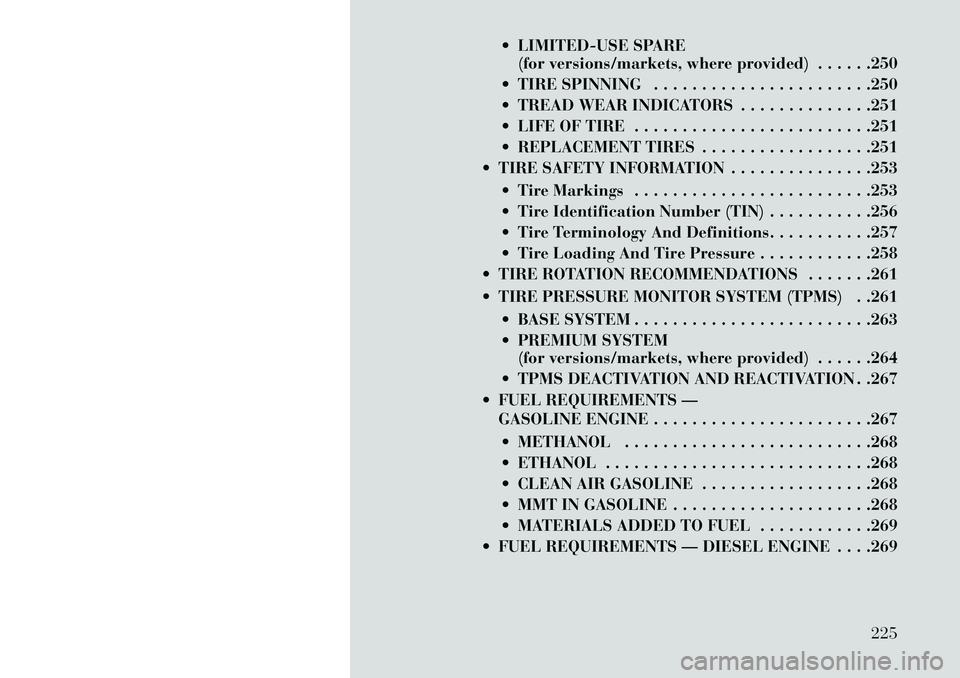
LIMITED-USE SPARE(for versions/markets, where provided) . . . . . .250
TIRE SPINNING . . . . . . . . . . . . . . . . . . . . . . .250
TREAD WEAR INDICATORS . . . . . . . . . . . . . .251
LIFE OF TIRE . . . . . . . . . . . . . . . . . . . . . . . . .251
REPLACEMENT TIRES . . . . . . . . . . . . . . . . . .251
TIRE SAFETY INFORMATION . . . . . . . . . . . . . . .253
Tire Markings . . . . . . . . . . . . . . . . . . . . . . . . .253
Tire Identification Number (TIN) . . . . . . . . . . .256
Tire Terminology And Definitions. . . . . . . . . . .257
Tire Loading And Tire Pressure . . . . . . . . . . . .258
TIRE ROTATION RECOMMENDATIONS . . . . . . .261
TIRE PRESSURE MONITOR SYSTEM (TPMS) . .261
BASE SYSTEM . . . . . . . . . . . . . . . . . . . . . . . . .263
PREMIUM SYSTEM(for versions/markets, where provided) . . . . . .264
TPMS DEACTIVATION AND REACTIVATION . .267
FUEL REQUIREMENTS — GASOLINE ENGINE . . . . . . . . . . . . . . . . . . . . . . .267
METHANOL . . . . . . . . . . . . . . . . . . . . . . . . . .268
ETHANOL . . . . . . . . . . . . . . . . . . . . . . . . . . . .268
CLEAN AIR GASOLINE . . . . . . . . . . . . . . . . . .268
MMT IN GASOLINE . . . . . . . . . . . . . . . . . . . . .268
MATERIALS ADDED TO FUEL . . . . . . . . . . . .269
FUEL REQUIREMENTS — DIESEL ENGINE . . . .269
225
Page 232 of 360
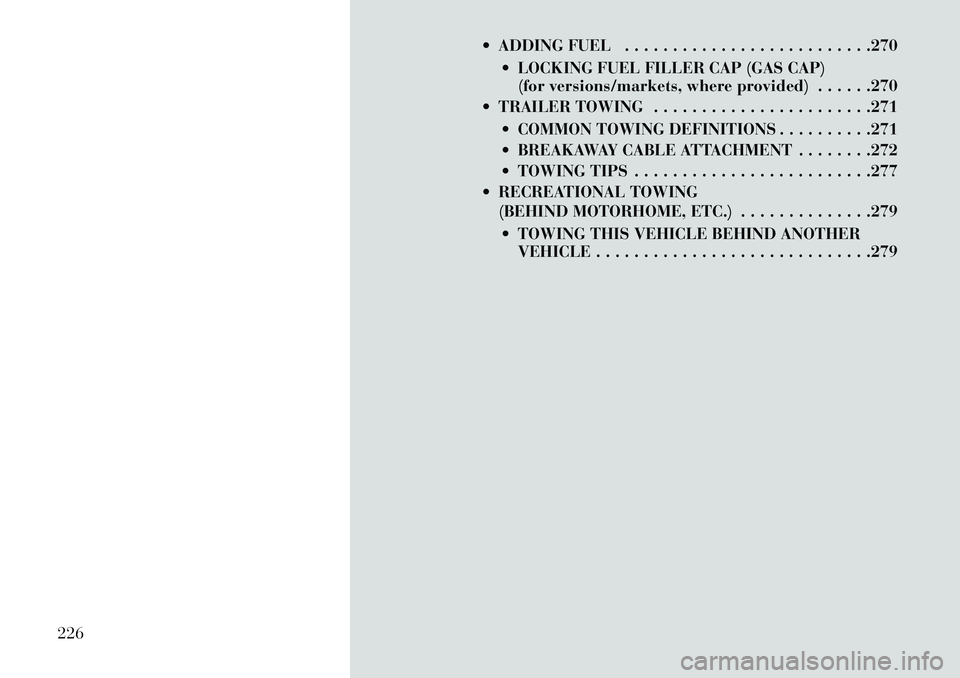
ADDING FUEL . . . . . . . . . . . . . . . . . . . . . . . . . .270 LOCKING FUEL FILLER CAP (GAS CAP)(for versions/markets, where provided) . . . . . .270
TRAILER TOWING . . . . . . . . . . . . . . . . . . . . . . .271
COMMON TOWING DEFINITIONS . . . . . . . . . .271
BREAKAWAY CABLE ATTACHMENT . . . . . . . .272
TOWING TIPS . . . . . . . . . . . . . . . . . . . . . . . . .277
RECREATIONAL TOWING (BEHIND MOTORHOME, ETC.) . . . . . . . . . . . . . .279
TOWING THIS VEHICLE BEHIND ANOTHER VEHICLE . . . . . . . . . . . . . . . . . . . . . . . . . . . . .279
226
Page 233 of 360
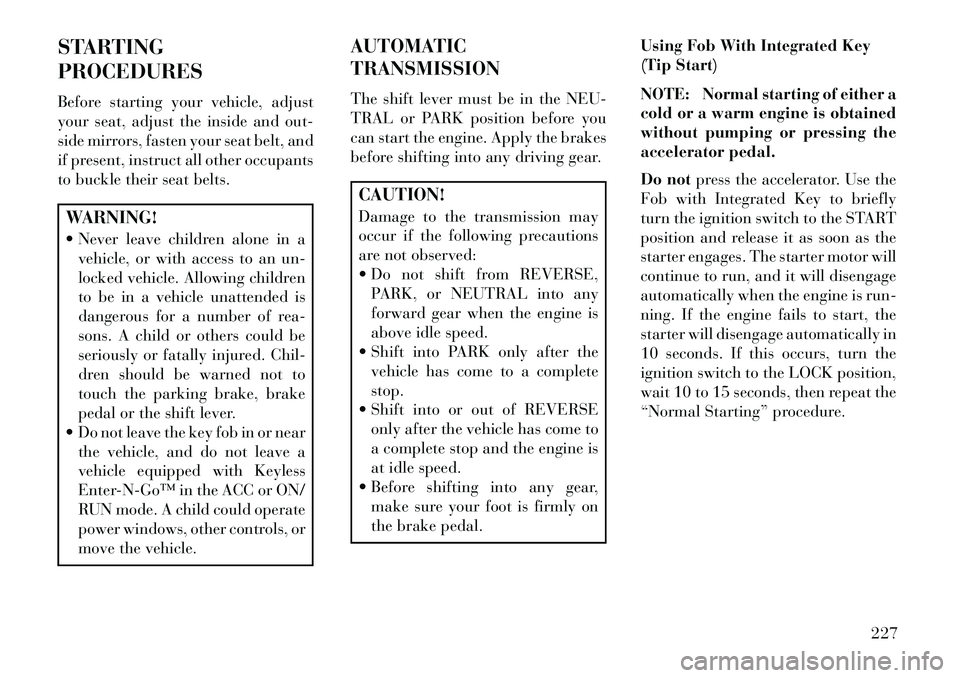
STARTING
PROCEDURES
Before starting your vehicle, adjust
your seat, adjust the inside and out-
side mirrors, fasten your seat belt, and
if present, instruct all other occupants
to buckle their seat belts.WARNING!
Never leave children alone in avehicle, or with access to an un-
locked vehicle. Allowing children
to be in a vehicle unattended is
dangerous for a number of rea-
sons. A child or others could be
seriously or fatally injured. Chil-
dren should be warned not to
touch the parking brake, brake
pedal or the shift lever.
Do not leave the key fob in or near the vehicle, and do not leave a
vehicle equipped with Keyless
EnterNGo™ in the ACC or ON/
RUN mode. A child could operate
power windows, other controls, or
move the vehicle. AUTOMATIC
TRANSMISSION
The shift lever must be in the NEU-
TRAL or PARK position before you
can start the engine. Apply the brakes
before shifting into any driving gear.
CAUTION!
Damage to the transmission may
occur if the following precautions
are not observed:
Do not shift from REVERSE,
PARK, or NEUTRAL into any
forward gear when the engine is
above idle speed.
Shift into PARK only after the vehicle has come to a complete
stop.
Shift into or out of REVERSE only after the vehicle has come to
a complete stop and the engine is
at idle speed.
Before shifting into any gear, make sure your foot is firmly on
the brake pedal. Using Fob With Integrated Key
(Tip Start)
NOTE: Normal starting of either a
cold or a warm engine is obtained
without pumping or pressing the
accelerator pedal.
Do not
press the accelerator. Use the
Fob with Integrated Key to briefly
turn the ignition switch to the START
position and release it as soon as the
starter engages. The starter motor will
continue to run, and it will disengage
automatically when the engine is run-
ning. If the engine fails to start, the
starter will disengage automatically in
10 seconds. If this occurs, turn the
ignition switch to the LOCK position,
wait 10 to 15 seconds, then repeat the
“Normal Starting” procedure.
227
Page 234 of 360

KEYLESS ENTER-N-GO
(for versions/markets,
where provided)
This feature allows
the driver to operate
the ignition switch
with the push of a
button, as long as
the ENGINE
START/STOP but-
ton is installed and the Remote Keyless
Entry (RKE) transmitter is in the pas-
senger compartment.
Installing And Removing The
ENGINE START/STOP Button
Installing The Button
1. Remove the key fob from the igni-
tion switch.
2. Insert the ENGINE START/STOP
button into the ignition switch with
the lettering facing up and readable.
3. Press firmly on the center of the
button to secure it into position. Removing The Button
1. The ENGINE START/STOP but-
ton can be removed from the ignition
switch for key fob use.
2. Insert the metal part of the emer-
gency key under the chrome bezel at
the 6 o’clock position and gently pry
the button loose.
NOTE: The ENGINE START/
STOP button should only be re-
moved or inserted with the ignition
in the OFF position (OFF position
for Keyless EnterNGo™).
NORMAL STARTING —
GASOLINE ENGINE
Using The ENGINE START/STOP
Button
NOTE: Normal starting of either
a cold or a warm engine is ob-
tained without pumping or press-
ing the accelerator pedal.
To start the engine, the transmission
must be in PARK or NEUTRAL. Press
and hold the brake pedal while press-
ing the ENGINE START/STOP but-
ton once. The system takes over andattempts to start the vehicle. If the
vehicle fails to start, the starter will
disengage automatically after 10 sec-
onds. If you wish to stop the cranking
of the engine prior to the engine start-
ing, press the button again.
To Turn Off The Engine Using
ENGINE START/STOP Button
1. Place the shift lever in PARK, then
press and release the ENGINE
START/STOP button.
2. The ignition switch will return to
the OFF position.
3. If the shift lever is not in PARK and
the vehicle speed is above 8 km/h, the
ENGINE START/STOP button must
be held for two seconds before the
engine shuts off. The ignition switch
position will remain in the ACC posi-
tion until the shift lever is in PARK
and the button is pressed twice to the
OFF position. If the shift lever is not
in PARK and the ENGINE START/
STOP button is pressed once, the
EVIC will display a “Vehicle Not In
Park” message and the engine will228
Page 235 of 360

remain running. Never leave a vehicle
out of the PARK position, or it could
roll.
NOTE: If the ignition switch is left
in the ACC or RUN (engine not run-
ning) position and the transmis-
sion is in PARK, the system will
automatically time out after 30
minutes of inactivity and the igni-
tion will switch to the OFF posi-
tion.
Keyless EnterNGo™ Functions –
With Driver’s Foot OFF The
Brake Pedal (In PARK Or
NEUTRAL Position)
The Keyless EnterNGo™ feature
operates similar to an ignition switch.
It has four positions, OFF, ACC, RUN
and START. To change the ignition
switch positions without starting the
vehicle and use the accessories follow
these steps. Starting with the ignition switch in
the OFF position:
Press the ENGINE START/STOP button once to change the ignition
switch to the ACC position (EVIC
displays “IGNITION MODE
ACCESSORY”),
Press the ENGINE START/STOP button a second time to change the
ignition switch to the RUN position
(EVIC displays “IGNITION MODE
RUN”),
Press the ENGINE START/STOP button a third time to return the
ignition switch to the OFF position
(EVIC displays “IGNITION MODE
OFF”).
EXTREME COLD
WEATHER (BELOW �29°C)
To ensure reliable starting at these
temperatures, use of an externally
powered electric engine block heater
is recommended. IF ENGINE FAILS TO
START
WARNING!
Never pour fuel or other flam-
mable liquids into the throttle
body air inlet opening in an at-
tempt to start the vehicle. This
could result in a flash fire causing
serious personal injury.
Do not attempt to push or tow your vehicle to get it started. Ve-
hicles equipped with an auto-
matic transmission cannot be
started this way. Unburned fuel
could enter the catalytic con-
verter and once the engine has
started, ignite and damage the
converter and vehicle.
If the vehicle has a discharged
battery, booster cables may be
used to obtain a start from a
booster battery or the battery in
another vehicle. This type of start
can be dangerous if done improp-
erly. Refer to “Jump Starting” in
“What To Do In Emergencies” for
further information.
229
Page 236 of 360

Clearing A Flooded Engine (Using
ENGINE START/STOP Button)
If the engine fails to start after you
have followed the “Normal Starting”
or “Extreme Cold Weather" proce-
dures, it may be flooded. To clear any
excess fuel:
1. Press and hold the brake pedal.
2. Press the accelerator pedal all the
way to the floor and hold it.
3. Press and release the ENGINE
START/STOP button once.
The starter motor will engage auto-
matically, run for 10 seconds, and
then disengage. Once this occurs, re-
lease the accelerator pedal and the
brake pedal, wait 10 to 15 seconds,
then repeat the “Normal Starting”
procedure.
Clearing A Flooded Engine (Using
Fob With Integrated Key)
If the engine fails to start after you
have followed the “Normal Starting”
or “Extreme Cold Weather” proce-
dures, it may be flooded. To clear any
excess fuel:1. Press the accelerator pedal all the
way to the floor and hold it.
2. Turn the ignition switch to the
START position and release it as soon
as the starter engages.
The starter motor will disengage au-
tomatically in 10 seconds. Once this
occurs, release the accelerator pedal,
turn the ignition switch to the LOCK
position, wait 10 to 15 seconds, then
repeat the “Normal Starting” proce-
dure.
CAUTION!
To prevent damage to the starter,
wait 10 to 15 seconds before trying
again.
AFTER STARTING
The idle speed is controlled automati-
cally and it will decrease as the engine
warms up.
NORMAL STARTING –
DIESEL ENGINE
1. Turn the ignition switch to the ON
position. 2. Watch for the “Wait To Start
Light” in the instrument cluster. Refer
to “Instrument Cluster” in “Under-
standing Your Instrument Panel” for
further information. It will illuminate
for two to ten seconds or more, de-
pending on engine temperature.
When the “Wait To Start Light” goes
out, the engine is ready to start.
3. DO NOT press the accelerator.
Turn the ignition switch to the START
position and release when the engine
starts.
CAUTION!
To prevent damage to the starter,
DO NOT crank the engine for more
than 15–second intervals at one
time. Wait 10 to 15 seconds before
trying again.
4. After the engine starts, allow it to
idle for approximately 30 seconds be-
fore driving. This allows oil to circu-
late and lubricate the turbocharger.
230
Page 237 of 360
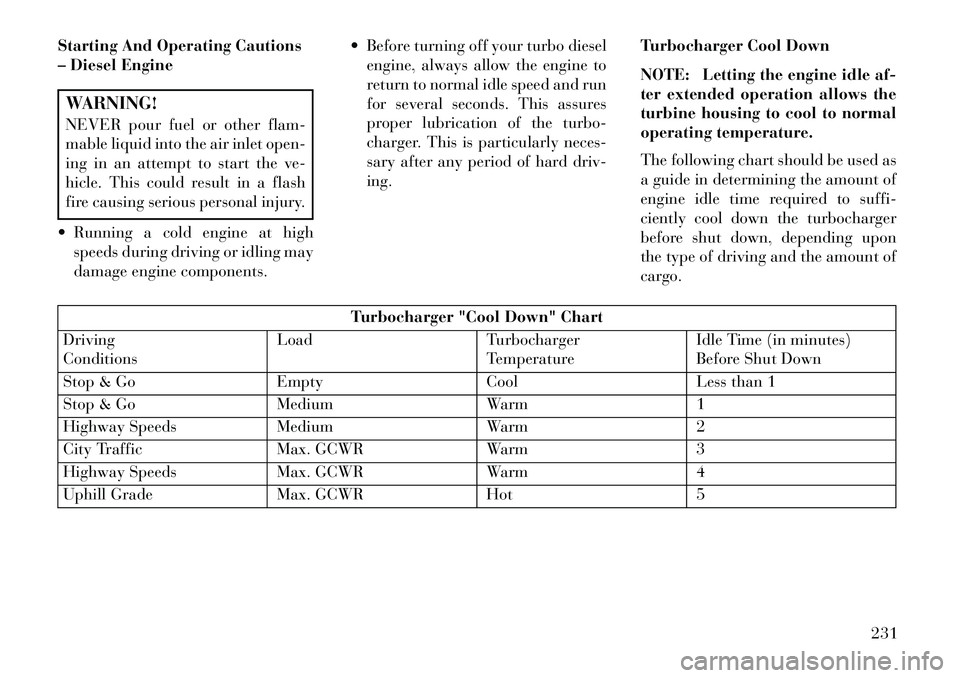
Starting And Operating Cautions
– Diesel EngineWARNING!
NEVER pour fuel or other flam-
mable liquid into the air inlet open-
ing in an attempt to start the ve-
hicle. This could result in a flash
fire causing serious personal injury.
Running a cold engine at high speeds during driving or idling may
damage engine components. Before turning off your turbo diesel
engine, always allow the engine to
return to normal idle speed and run
for several seconds. This assures
proper lubrication of the turbo-
charger. This is particularly neces-
sary after any period of hard driv-
ing. Turbocharger Cool Down
NOTE: Letting the engine idle
af-
ter extended operation allows the
turbine housing to cool to normal
operating temperature.
The following chart should be used as
a guide in determining the amount of
engine idle time required to suffi-
ciently cool down the turbocharger
before shut down, depending upon
the type of driving and the amount of
cargo.
Turbocharger "Cool Down" Chart
Driving
Conditions Load Turbocharger
TemperatureIdle Time (in minutes)
Before Shut Down
Stop & Go EmptyCoolLess than 1
Stop & Go MediumWarm1
Highway Speeds MediumWarm2
City Traffic Max. GCWRWarm3
Highway Speeds Max. GCWRWarm4
Uphill Grade Max. GCWRHot5
231
Page 238 of 360
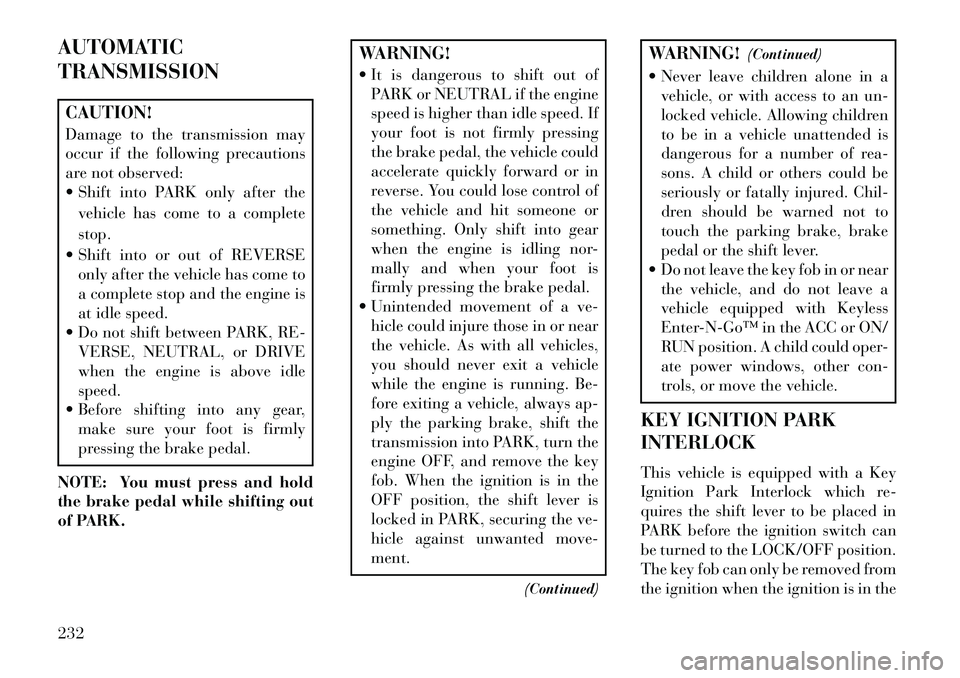
AUTOMATIC
TRANSMISSIONCAUTION!
Damage to the transmission may
occur if the following precautions
are not observed:
Shift into PARK only after thevehicle has come to a complete
stop.
Shift into or out of REVERSE only after the vehicle has come to
a complete stop and the engine is
at idle speed.
Do not shift between PARK, RE- VERSE, NEUTRAL, or DRIVE
when the engine is above idle
speed.
Before shifting into any gear, make sure your foot is firmly
pressing the brake pedal.
NOTE: You must press and hold
the brake pedal while shifting out
of PARK.
WARNING!
It is dangerous to shift out of PARK or NEUTRAL if the engine
speed is higher than idle speed. If
your foot is not firmly pressing
the brake pedal, the vehicle could
accelerate quickly forward or in
reverse. You could lose control of
the vehicle and hit someone or
something. Only shift into gear
when the engine is idling nor-
mally and when your foot is
firmly pressing the brake pedal.
Unintended movement of a ve- hicle could injure those in or near
the vehicle. As with all vehicles,
you should never exit a vehicle
while the engine is running. Be-
fore exiting a vehicle, always ap-
ply the parking brake, shift the
transmission into PARK, turn the
engine OFF, and remove the key
fob. When the ignition is in the
OFF position, the shift lever is
locked in PARK, securing the ve-
hicle against unwanted move-
ment.
(Continued)
WARNING!(Continued)
Never leave children alone in a vehicle, or with access to an un-
locked vehicle. Allowing children
to be in a vehicle unattended is
dangerous for a number of rea-
sons. A child or others could be
seriously or fatally injured. Chil-
dren should be warned not to
touch the parking brake, brake
pedal or the shift lever.
Do not leave the key fob in or near the vehicle, and do not leave a
vehicle equipped with Keyless
EnterNGo™ in the ACC or ON/
RUN position. A child could oper-
ate power windows, other con-
trols, or move the vehicle.
KEY IGNITION PARK
INTERLOCK
This vehicle is equipped with a Key
Ignition Park Interlock which re-
quires the shift lever to be placed in
PARK before the ignition switch can
be turned to the LOCK/OFF position.
The key fob can only be removed from
the ignition when the ignition is in the
232
Page 239 of 360
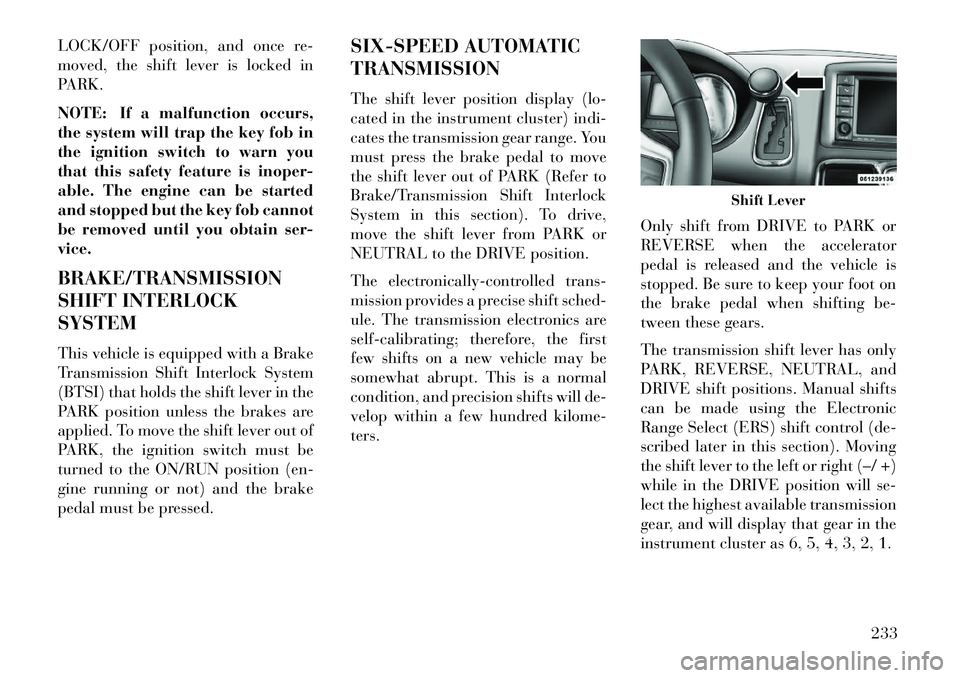
LOCK/OFF position, and once re-
moved, the shift lever is locked in
PARK.
NOTE: If a malfunction occurs,
the system will trap the key fob in
the ignition switch to warn you
that this safety feature is inoper-
able. The engine can be started
and stopped but the key fob cannot
be removed until you obtain ser-
vice.
BRAKE/TRANSMISSION
SHIFT INTERLOCK
SYSTEM
This vehicle is equipped with a Brake
Transmission Shift Interlock System
(BTSI) that holds the shift lever in the
PARK position unless the brakes are
applied. To move the shift lever out of
PARK, the ignition switch must be
turned to the ON/RUN position (en-
gine running or not) and the brake
pedal must be pressed.SIX-SPEED AUTOMATIC
TRANSMISSION
The shift lever position display (lo-
cated in the instrument cluster) indi-
cates the transmission gear range. You
must press the brake pedal to move
the shift lever out of PARK (Refer to
Brake/Transmission Shift Interlock
System in this section). To drive,
move the shift lever from PARK or
NEUTRAL to the DRIVE position.
The electronically-controlled trans-
mission provides a precise shift sched-
ule. The transmission electronics are
self-calibrating; therefore, the first
few shifts on a new vehicle may be
somewhat abrupt. This is a normal
condition, and precision shifts will de-
velop within a few hundred kilome-
ters.
Only shift from DRIVE to PARK or
REVERSE when the accelerator
pedal is released and the vehicle is
stopped. Be sure to keep your foot on
the brake pedal when shifting be-
tween these gears.
The transmission shift lever has only
PARK, REVERSE, NEUTRAL, and
DRIVE shift positions. Manual shifts
can be made using the Electronic
Range Select (ERS) shift control (de-
scribed later in this section). Moving
the shift lever to the left or right (–/ +)
while in the DRIVE position will se-
lect the highest available transmission
gear, and will display that gear in the
instrument cluster as 6, 5, 4, 3, 2, 1.
Shift Lever
233
Page 240 of 360
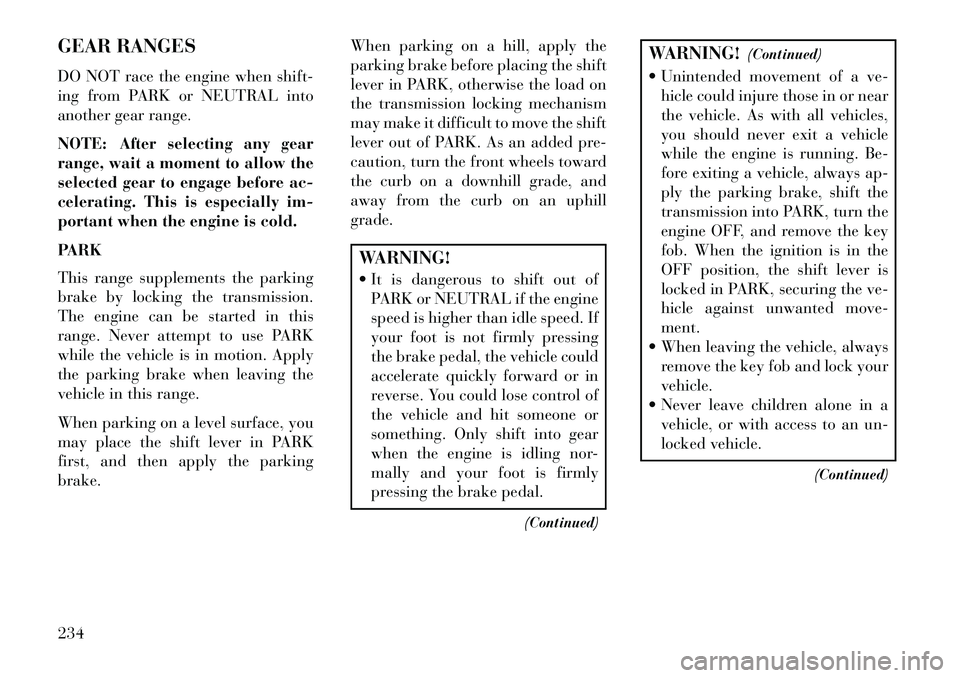
GEAR RANGES
DO NOT race the engine when shift-
ing from PARK or NEUTRAL into
another gear range.
NOTE: After selecting any gear
range, wait a moment to allow the
selected gear to engage before ac-
celerating. This is especially im-
portant when the engine is cold.
PARK
This range supplements the parking
brake by locking the transmission.
The engine can be started in this
range. Never attempt to use PARK
while the vehicle is in motion. Apply
the parking brake when leaving the
vehicle in this range.
When parking on a level surface, you
may place the shift lever in PARK
first, and then apply the parking
brake.When parking on a hill, apply the
parking brake before placing the shift
lever in PARK, otherwise the load on
the transmission locking mechanism
may make it difficult to move the shift
lever out of PARK. As an added pre-
caution, turn the front wheels toward
the curb on a downhill grade, and
away from the curb on an uphill
grade.
WARNING!
It is dangerous to shift out of
PARK or NEUTRAL if the engine
speed is higher than idle speed. If
your foot is not firmly pressing
the brake pedal, the vehicle could
accelerate quickly forward or in
reverse. You could lose control of
the vehicle and hit someone or
something. Only shift into gear
when the engine is idling nor-
mally and your foot is firmly
pressing the brake pedal.
(Continued)
WARNING!(Continued)
Unintended movement of a ve- hicle could injure those in or near
the vehicle. As with all vehicles,
you should never exit a vehicle
while the engine is running. Be-
fore exiting a vehicle, always ap-
ply the parking brake, shift the
transmission into PARK, turn the
engine OFF, and remove the key
fob. When the ignition is in the
OFF position, the shift lever is
locked in PARK, securing the ve-
hicle against unwanted move-
ment.
When leaving the vehicle, always remove the key fob and lock your
vehicle.
Never leave children alone in a vehicle, or with access to an un-
locked vehicle.
(Continued)
234